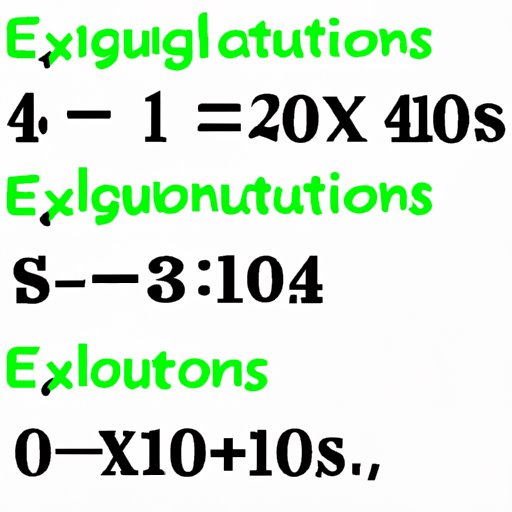
Understanding Extraneous Solutions: A Beginner’s Guide
Algebraic equations are an essential part of mathematical problem-solving, and a fundamental concept from high school mathematics to higher education. Solving algebraic equations can be a daunting task, especially if one is not aware of the concept of extraneous solutions. Simply put, extraneous solutions are solutions that do not satisfy the original equation but appear as solutions due to some algebraic manipulations.
Defining Extraneous Solutions
Extraneous solutions are a complex concept in algebraic equations that can lead to incorrect solutions. In algebraic equations, we manipulate equations using different methods like adding, subtracting, multiplying, and dividing, to arrive at the solutions. However, while solving complex mathematical problems, the solutions can turn out to be incorrect.
False solutions occur when an algebraic manipulation results in the introduction of a variable or a term that is outside the domain of the original equation. This new variable or term often cancels out while solving the equation, and the final answer seems correct. Nevertheless, when the result is substituted into the original equation, there is a contradiction, and the solution turns out to be incorrect. Such incorrect solutions are known as extraneous solutions.
The identification of extraneous solutions is crucial since they can significantly alter the outcome of an equation. Therefore, it is essential to be aware of how they arise, why they occur, and how to identify them.
Examples of Algebraic Equations Resulting in Extraneous Solutions
Solving algebraic equations requires an extensive problem-solving approach. We examine some of the common algebraic equations and highlight how to avoid extraneous solutions.
One common equation that leads to extraneous solutions is one that involves a rational expression such as,
When solving this equation, we notice that the result x=3 satisfies the equation. Nevertheless, when substituting x=3 back into the original equation, the left-hand side of the equation becomes undefined since we have division by zero, and thus x=3 is an extraneous solution.
Role of Extraneous Solutions in Real-Life Situations
Extraneous solutions can be problematic in real-life situations. For instance, in engineering or physics problems, the incorrect solution of an equation that leads to an extraneous solution can lead to safety hazards or material damage.
Mathematical Tools and Techniques to Reduce Likelihood of Extraneous Solutions
Several techniques can help mitigate extraneous solutions. For example, one should simplify the equation before solving it. Often the expression’s complexity hinders the identification of the correct solution, leading to the selection of an extraneous solution. Simplicity makes it easier to identify the correct solution, thus reducing the likelihood of selecting an extraneous solution.
Another technique that can be used is working with the equation’s roots as solutions. The importance of verifying roots cannot be overstated. This is because solutions that seem correct at first glance can be incorrect when substituted back into the original equation to test their authenticity.
Common Mistakes That Lead to Extraneous Solutions
The most common mistake that leads to extraneous solutions is improper simplification of equations. This can include incorrect distribution of exponents or an improper reduction of fractions. Another common mistake that causes extraneous solutions is mistaking parts of an equation. For instance, the numerator or denominator of a fraction can easily be interchanged, leading to an incorrect result.
Test for Readers
Readers can use the following problem to test their understanding of extraneous solutions:
Solve the following equation
Upon solving the equation, check to identify if the result shows any extraneous solution.
Conclusion
In conclusion, solving algebraic equations is a critical aspect of mathematical problem-solving. However, it is essential to be aware of extraneous solutions to avoid incorrect results. Understanding how they arise, why they occur, and how to identify them by simplifying equations, testing roots, and avoiding common mistakes is the key to arriving at the correct solutions.




